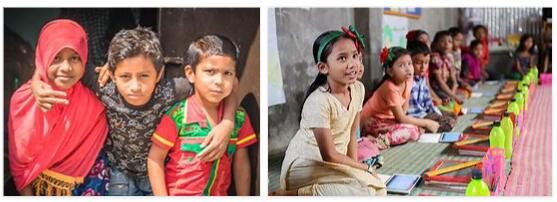3: The Bangladesh Paradox
Progress in Bangladeshis in many ways a paradox. The country has a population of around 153 million and is the eighth most populous country in the world. Thirty years ago, the prospects for Bangladesh were bleak. It was a country many believed would be dependent on aid for all time to come due to widespread poverty and few natural resources. The country is also particularly vulnerable and exposed to natural disasters such as tsunamis, floods and earthquakes. When Bangladesh was divided from Pakistan in 1971, many observers doubted whether the country could survive as an independent state. Famine and political instability were reflected in repeated military coups – in 1975, 1982 and 2007. Therefore, it is against all odds that Bangladesh in a short time has managed to improve the health of the population. In the period 1990 to 2010, the average life expectancy increased by as much as 10 years, from 59 to 69 years.
Even more remarkable is that the increase in life expectancy also applies to the poorest part of the population. Bangladesh was in 2013 placed as no. 146 on the UN organization UNDP Human Development Index (Human Development Index). This index is a list where all countries in the world are ranked based on what level of development they are at. The ranking is based, among other things, on living standards (cf. poverty), education and health (life expectancy).
According to HEALTHVV.COM, the success in Bangladesh is linked to the UN’s fourth millennium goal of reducing child mortality by two thirds by 2015. Data from the UN (UNICEF) show a remarkable decline from 139 child deaths per 1,000 live births in 1990 to 46 in 2011. Good vaccine programs, control of diarrhea and nutritional supplementation of vitamin A has meant a lot for the good result. In addition, well-implemented family planning programs have led to a significant reduction in the number of children per woman . This decline – from almost 6 children in 1975 to almost 2 in 2012 – also means a lot as it frees up resources and time for care per child.
But while such solutions may seem simple and inexpensive, challenges can arise when deploying a system that lacks resources, skilled labor, and equipment. Bangladesh has 0.5 doctors and 2 nurses per 1000 inhabitants. The country spends only 3.7 percent of GDP on health, of which one third is public funds. The percentage of GDP on health is small even compared to countries with which it is natural to compare. Nevertheless, these solutions are described as exemplary compared to neighboring countries in Asia.
The Lancet report highlights several possible explanations for the sharp decline in child mortality in Bangladesh. For the first is the world’s largest development organization BRAC (Bangladesh Rehabilitation Assistance Committee) established in Bangladesh, and it is present in all the country’s districts. The state is not solely responsible for the provision of health services. Since Bangladesh became independent in 1971, the BRAC has trained nearly 120,000 local health workers and implemented many of the measures now described as exemplary. The microfinance programs of the Grameen Foundation are also highlighted as a factor that has helped to create this positive development.
For the second points to the importance of assistance . In the important years after the liberation and up to approx. In 1990, development assistance accounted for as much as 6 per cent of GDP and financed 70 per cent of all investment in the early 1970s. There are divided opinions about the importance of development assistance for Bangladesh. But it is often emphasized that the donor countries’ investment in BRAC has been decisive. This has led to a significant access to resources and flexible cooperation between private and state actors. In addition, the country’s far-sighted gender policy in terms of education, work and political participation for women is emphasized as crucial, not only for child health, but for the health of the entire population.
4: Invest in women, it pays off
In recent years, there have been signals from many quarters about how important it is to focus on women. In May 2012, Hillary Clinton visited Norway where she attended a seminar with the then Minister of Foreign Affairs, Jonas Gahr Støre. The two discussed global health policy. The seminar was mainly about a Norwegian-American commitment to gender equality, women’s and children’s rights. Gender equality is a good economy, Støre said, and continued: Women’s entry into and participation in working life in Norway has had a greater impact on the Norwegian economy than the oil discoveries in the North Sea.
In 2013, Clinton launched a new large project ” The Full Participation Project ” with the aim of providing solid data on the importance of women’s participation in society. Furthermore, in 2012, UN Secretary-General Ban Ki-moon spoke at the World Economic Forum (in Davos) about the importance of, and concern about, the growing inequality in the global economy, the widening gap between the world rich and poor – and especially about “Women who the way forward”. The World Bank also now emphasizes the importance of investing in women as a smart economy to promote economic growth and social progress. Investing in women has become a global movement that is being embraced by more and more players – also a major manufacturer of sports equipment is on the field with its campaign “Girl Effect”. Investing in women has become the most profitable strategy of our time: “Invest in Women, it Pays”









